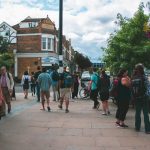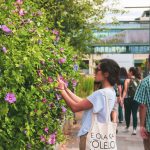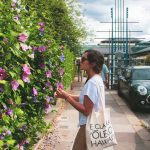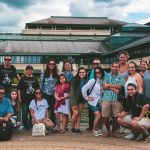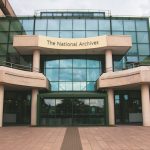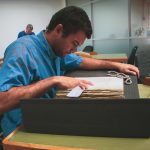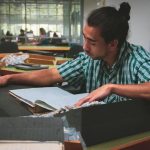Today, July 18, is our first day in downtown London and we visited the British National Archives in London, England. The England air is crisp and cool in the morning and sun stays up until 9:10pm. We started our journey by bus and train to Kew early in the morning, and arrived to a quaint small town, walking through adorable small homes to get to an unexpected clearing for the large National Archives site.
Bringing the phrase “na keiki Hawaiʻi Imi Naʻauao” a new meaning, our group today had a fulfilling day at the National Archives at Kew. We prepared in advance by requesting documents ahead of time, all of which were waiting for us once we all registered and got ID cards to access the archives. With a document, folder or box in front of each of us, we each opened them up to see what piece of our rich history lay within. Just moments in, Kamuela Park discovered that his small, unassuming folder held one of the gems of the day: the original Anglo Franco Proclamation from November 28, 1843! This find generated energy, flurry and emotion that sustained us throughout the day. We also came across a wealth of other important finds, cementing the deep and long connections between the Hawaiian Kingdom and our aliʻi, and the United Kingdom and their own leaders and diplomats.
Joseph Kamauoha
by Jarena Makana Pacarro, UG Student in Hawaiian Studies & MEd Student in Education Aloha ʻĀina (Fall 2018)

In 1883, the Hawaiian-language newspaper Ke Koo o Hawaiʻi, writes about three keiki Hawaiʻi Imi Naʻauao, three young men who travelled to London, England to study abroad. One of these young men was named Joseph A. Kamauoha, a former student of Punahou School during 1880 and 1882. Kamauoha, along with Matthew Makalua and Abraham Piʻianaia traveled to England under the care of Manley Hopkins, His Majesty King Kalākauaʻs Consul-General in England.
Joseph A. Kamauoha was selected by Kalākaua to expand his understanding of the world through education. Kamauoha attended the King’s College in London, which is known for its Arts, Humanities, Life Sciences and Medicine. Kingʻs College is located in the heart of London near the River Thames. Kamauoha attended Kingʻs College in 1882 when the school had just started admitting women into the school. He studied English, Latin, French and Math in his first year and by his second year, he was studying Chemistry, Trigonometry and Mechanics. He was quite studious and perhaps not very social. In his correspondences with Hawaiʻi, Manley Hopkins comments on Kamauoha in writing that, “Kamauoha is prudent, studious, diligent: give no ground for complaint in anyway, but is rather dull in conversation: indeed speaks but little.”
Kamauoha’s quiet and humble demeanor was further highlighted in an editorial found in The Globe, a London based newspaper, entitled, “A Modest Rescuer.” In the editorial Hopkins shares a story about a young Hawaiian man who rescues two men who fell off a plank while loading a ship. The Hawaiian man dragged the first man to the wharf and then proceeded to save the other man who fell after. After he saved the two men this Hawaiian man “immediately lost himself in the crowd” and “it was unknown to whom the two lives saved were indebted.” Hopkins then reveals that this Hawaiian man, who rescued these two men, was Joseph Kamauoha. Showing himself to be strong, intelligent and humble and not outshine others, Kamauoha’s actions reminds me of our kupunaʻs words, “Kuʻia ka hele a ka naʻaua haʻahaʻa. Hesitant walks the humble hearted. A humble person walks carefully so he will not hurt those around him.”[1]
As Kamauoha continued his studies at Kingʻs College he adds photography to his class load which tells us of his artistic abilities. Hopkins indicates that he had to purchase all kinds of equipment for his coursework. I wonder what ever happened to all the photos that Kamauoha would have taken during his studies. Kamauoha was a very active young man and did not seem to squander His Majestyʻs financial support while studying in London, however, the weather was quite challenging for him. The cold winters soon challenged his physical body that was made for a more tropical climate. In an update letter to His Majesty, dated October, 1885, Hopkins shares that Joseph was “suffering somewhat in health. I wrote that he had had a little trouble with one hand requiring slight operation and that a chill had occasioned an inflammation in his eye. Since then, he has had an attack of pleurisy, no severe, but not yet entirely removed.”[2] It seemed that after his arrival the London, winter started to take a toll on his body, so Hopkins moved Joseph to Torquay, England. Hopkins refers to this city as the “frying-pan of England” in his February 25, 1886 letter to His Majesty Kalakaua. Being further away from his friends, humble and quiet Kamauoha made friends in Torquay. Sadly, in a letter dated March 27, 1886, Hopkins, announces the death of Joseph A. Kamauoha the day before in Torquay. He says, “Very kind friends in the Boarding House at Torquay attended his bed-side, and he had every comfort. Thus we lose a fine, promising young man of high moral character.”[3] I’m sure that this was a great loss to his two friends Makalua and Piʻianaia, yet it was an even greater loss for all of Hawaiʻi who considered him ka imi naʻauao.
Sorrowfully, Mr. Hopkins had to plan Joseph Kamauoha’s funeral services and and burial in Torquay. Interestingly, Mr. Hopkinsʻ letter advising His Majesty of his death closes with a postscript that indicates that the medical fees for Kamauoha during his failing health had a “great weight upon the nearly exhausted funds.”[4] Today, Kamauoha’s remains are located in Torquay, England and although it is not on our itinerary this trip, I hope that the Hawaii Youths Abroad can visit in the near future. I wonder if someday he can come home to Hawaiʻi where he belongs.
The story of Kamauoha told side-by-side here with our National Archives visit reminds us that Hawaiian experiences are etched in this place. Even when, on the surface, everything seems so foreign here, there are so many things that are familiar. We are continually being surprised every day to discover more and more evidence of our country’s rich and proud history in archives, castles, and churches spread across this city and country.
Photo Credits: Anianikū Chong
[1] Pukui, M. K. ʻŌlelo Noʻeau: Hawaiian Proverbs and Sayings. 1983. Bishop Museum Press. P201
[2] 13 Oct. 1885. Letter to His Majesty Kalakaua from Manley Hopkins. Hawaiian Consulate London.
[3] 27th Mar. 1886. Letter to His Majesty Kalakaua from Manley Hopkins. Hawaiian Consulate London.
[4] Ibid.



